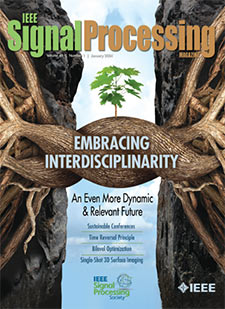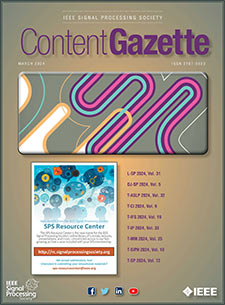- Our Story
- Publications & Resources
- Publications & Resources
- Publications
- IEEE Signal Processing Magazine
- IEEE Journal of Selected Topics in Signal Processing
- IEEE Signal Processing Letters
- IEEE/ACM Transactions on Audio Speech and Language Processing
- IEEE Transactions on Computational Imaging
- IEEE Transactions on Image Processing
- IEEE Transactions on Information Forensics and Security
- IEEE Transactions on Multimedia
- IEEE Transactions on Signal and Information Processing over Networks
- IEEE Transactions on Signal Processing
- IEEE TCI
- IEEE TSIPN
- Data & Challenges
- Submit Manuscript
- Guidelines
- Information for Authors
- Special Issue Deadlines
- Overview Articles
- Top Accessed Articles
- SPS Newsletter
- SigPort
- SPS Resource Center
- Publications Feedback
- Publications FAQ
- Blog
- News
- Dataset Papers
- Conferences & Events
- Community & Involvement
- Professional Development
- For Volunteers
- Information for Authors-OJSP
-
Home
An Exciting Juncture for Signal Processing Research: On Building Bridges, Challenges, and Opportunities
Conferences Events IEEE JSTSP Article IEEE Signal Processing Magazine IEEE TIFS Article IEEE TMM Article IEEE TSP Article Jobs in Signal Processing Lectures Machine Learning Seasonal Schools Signal Processing News SPM Article SPS Distinguished Lectures SPS Newsletter Article SPS Webinar SPS Webinars SPS Webinar Series Webinar webinars -
Our Story
What is Signal Processing?

The technology we use, and even rely on, in our everyday lives –computers, radios, video, cell phones – is enabled by signal processing. Learn More » -
Publications & Resources
-
SPS Resources
- Signal Processing Magazine The premier publication of the society.
- SPS Newsletter Monthly updates in Signal Processing
- SPS Resource Center Online library of tutorials, lectures, and presentations.
- SigPort Online repository for reports, papers, and more.
- SPS Feed The latest news, events, and more from the world of Signal Processing.
-
SPS Resources
-
Conferences & Events
-
Community & Involvement
-
Membership
- Join SPS The IEEE Signal Processing Magazine, Conference, Discounts, Awards, Collaborations, and more!
- Chapter Locator Find your local chapter and connect with fellow industry professionals, academics and students
- Women in Signal Processing Networking and engagement opportunities for women across signal processing disciplines
- Students Scholarships, conference discounts, travel grants, SP Cup, VIP Cup, 5-MICC
- Young Professionals Career development opportunities, networking
- Get Involved
-
Technical Committees
- Applied Signal Processing Systems
- Audio and Acoustic Signal Processing
- Bio Imaging and Signal Processing
- Computational Imaging
- Image Video and Multidimensional Signal Processing
- Information Forensics and Security
- Machine Learning for Signal Processing
- Multimedia Signal Processing
- Sensor Array and Multichannel
- Signal Processing for Communication and Networking
- Signal Processing Theory and Methods
- Speech and Language Processing
- Technical Working Groups
- More TC Resources
-
Membership
-
Professional Development
-
Professional Development
- Mentoring Experiences for Underrepresented Young Researchers (ME-UYR)
- Micro Mentoring Experience Program (MiME)
- Distinguished Lecturer Program
- Distinguished Lecturers
- Distinguished Lecturer Nominations
- Past Lecturers
- Distinguished Industry Speaker Program
- Distinguished Industry Speakers
- Distinguished Industry Speaker Nominations
- Industry Resources
- IEEE Training Materials
- Jobs in Signal Processing: IEEE Job Site
-
Career Resources
- SPS Education Program Educational content in signal processing and related fields.
- Distinguished Lecturer Program Chapters have access to educators and authors in the fields of Signal Processing
- PROGRESS Initiative Promoting diversity in the field of signal processing.
- Job Opportunities Signal Processing and Technical Committee specific job opportunities
- Job Submission Form Employers may submit opportunities in the area of Signal Processing.
-
Professional Development
-
For Volunteers
-
For Board & Committee Members
- Board Agenda/Minutes* Agendas, minutes and supporting documentation for Board and Committee Members
- SPS Directory* Directory of volunteers, society and division directory for Board and Committee Members.
- Membership Development Reports* Insight into the Society’s month-over-month and year-over-year growths and declines for Board and Committee Members
-
For Board & Committee Members
Popular Pages
Today's:
- Submit a Manuscript
- (MLSP 2024) 2024 IEEE International Workshop on Machine Learning for Signal Processing
- Information for Authors
- IEEE Signal Processing Letters
- (SLT 2024) 2024 IEEE Spoken Language Technology Workshop
- SPS Scholarship Program
- IEEE Transactions on Multimedia
- IEEE/ACM Transactions on Audio Speech and Language Processing
- IEEE Transactions on Image Processing
- IEEE Transactions on Information Forensics and Security
- Conference Call for Papers
- IEEE Signal Processing Magazine
- Information for Authors-SPL
- Signal Processing 101
- Interview with Chetan Arora, Associate Professor, IIT Delhi, India
All time:
- Information for Authors
- Submit a Manuscript
- IEEE Transactions on Image Processing
- 404 Page
- IEEE/ACM Transactions on Audio Speech and Language Processing
- IEEE Transactions on Information Forensics and Security
- IEEE Transactions on Multimedia
- IEEE Signal Processing Letters
- IEEE Transactions on Signal Processing
- Conferences & Events
- IEEE Journal of Selected Topics in Signal Processing
- Information for Authors-SPL
- Conference Call for Papers
- Signal Processing 101
- IEEE Signal Processing Magazine
Last viewed:
- What Are the Benefits of Speech Recognition Technology?
- Award Recipients
- IEEE Transactions on Image Processing
- Guidelines for Reviewers
- (ACSSC 2018) 2018 Asilomar Conference on Signals, Systems and Computers
- A Free Machine Learning Lecture Series on the SPS Resource Center!
- 5th Deep Noise Suppression Challenge: IEEE ICASSP 2023
- Submit a Manuscript
- Editorial Board
- (SiPS 2024) 2024 IEEE International Workshop on Signal Processing Systems
- MLSP TC Home
- (ICASSP 2025) 2025 IEEE International Conference on Acoustics, Speech and Signal Processing
- PostDoc Opportunities in Manaus - Amazonas - Brazil
- IEEE Signal Processing Magazine
- SPS Webinar: Joint Waveform and Beamforming Design for RIS-Aided ISAC Systems
Signal Processing Between Theory and Applications
You are here
Newsletter Menu
Newsletter Categories
Top Reasons to Join SPS Today!
1. IEEE Signal Processing Magazine
2. Signal Processing Digital Library*
3. Inside Signal Processing Newsletter
4. SPS Resource Center
5. Career advancement & recognition
6. Discounts on conferences and publications
7. Professional networking
8. Communities for students, young professionals, and women
9. Volunteer opportunities
10. Coming soon! PDH/CEU credits
Click here to learn more.
News and Resources for Members of the IEEE Signal Processing Society
Signal Processing Between Theory and Applications
Abdelhak Zoubir
Editor-in-Chief, SPM

Recently, a colleague visited my performance and gave a talk on the performance of third-generation and fourth-generation wireless systems. The seminar included a video that described the setup of the laboratory and numerous real-data results. This is quite unusual when the talk is on research in signal processing for wireless communications and, in particular, when it is given to an audience working mostly on statistical signal processing. Rather than theoretical development, the talk focused on interesting experimental validation. Among other outcomes, it was shown that implementations of the current standards still operate about 10 dB away from the Shannon bound. This conclusion was only possible with extensive (and expensive) experimental work performed by a group of academics, engineers, and research students. It should be stressed, however, that the validation would not have been possible without a deep understanding of theoretical results in the area.
At departmental meetings, conferences, or just at informal gatherings, we frequently discuss among colleagues the trend of signal processing as a well-established (sub)discipline of engineering. A large part of published work in signal processing journals and conferences is on theoretical analysis and algorithm developments. This is of utmost importance as it is the case, for example, of deriving statistical performance bounds, and of devising new techniques for target tracking and detection, parameter estimation, high-resolution imaging, and direction finding, to mention a few. These theoretical developments, however, should serve clear applications, drawn from their specificities and learn from their competing constraints. In essence, the applications help mentor our thinking and guide our intuition, putting our contributions in context. The experiments associated with the applications are also important, as they allow the testing of existing approaches and the revising of the assumed models and fine-tuning their parameters.
Over the past few years, a new theory of compressive sensing has emerged. Unlike in current practice where we compress measurements after sensing, this new theory allows the signal to be sampled and simultaneously compressed at a greatly reduced rate. In recent years, we have witnessed a flood of research papers in signal processing journals and conference proceedings, and IEEE Signal Processing Magazine (SPM) has been the home of an outstanding, well-cited lecture note [1] that appeared in the July 2007 issue and also a special issue published in March 2008, which consisted of many well-cited articles on the topic. The new theoretical advancement requires that we also put into practice this wonderful theory. There have already been a few systems that were built based on this new paradigm, including the one-pixel compressive sensing camera [1], which has also been used for hyperspectral data acquisition [2]. There is surely more to come...
A high impact of research on societal development is fundamental, and signal processing has a lot to offer to achieve this goal. Since its existence, signal processing has revolutionized numerous areas in the society we live today. There is also more to come, and SPM is a key player in this enterprise. Past and present editorial teams of SPM have tirelessly strived to identify and develop key areas for future research, which have had a large impact on the scientific community and the Society at large. In particular, the special issues of SPM have been enlightening and motivating for new research directions.
For the Sep'12 issue of SPM, I invited Fulvio Gini, an energetic and dedicated area editor (Special Issues), to write a brief on his editorial work. (Please read Fulvio's article " Maintaining SPM’s High Standards " by following this link.) He articulates the mechanisms of maintaining high-quality SPM special issues and raises some challenges of the future.
Our highest mandate is first-class publications as feature articles, special issue articles, or in columns and forums. I wish to encourage more colleagues to get involved and participate; I welcome your suggestions for timely and most interesting topics for special issues, feature articles, or columns.
REFERENCES
[1] R. G. Baraniuk, “Compressive sensing,” IEEE Signal Processing Mag., vol. 24, no. 4, pp. 118–124, 2007.
[2] C. Li, T. Sun, K. F. Kelly, and Y. Zhang, “A compressive sensing and unmixing scheme for hyperspectral data processing,” IEEE Trans. Image Processing, vol. 21, no. 3, pp. 1200–1210, Mar. 2012.
Open Calls
Publications News
Research Opportunities
Chapter & DL News
TC News
Initiatives & Trends
SPS on Twitter
- DEADLINE EXTENDED: The 2023 IEEE International Workshop on Machine Learning for Signal Processing is now accepting… https://t.co/NLH2u19a3y
- ONE MONTH OUT! We are celebrating the inaugural SPS Day on 2 June, honoring the date the Society was established in… https://t.co/V6Z3wKGK1O
- The new SPS Scholarship Program welcomes applications from students interested in pursuing signal processing educat… https://t.co/0aYPMDSWDj
- CALL FOR PAPERS: The IEEE Journal of Selected Topics in Signal Processing is now seeking submissions for a Special… https://t.co/NPCGrSjQbh
- Test your knowledge of signal processing history with our April trivia! Our 75th anniversary celebration continues:… https://t.co/4xal7voFER
Home | Sitemap | Contact | Accessibility | Nondiscrimination Policy | IEEE Ethics Reporting | IEEE Privacy Policy | Terms | Feedback
© Copyright 2024 IEEE – All rights reserved. Use of this website signifies your agreement to the IEEE Terms and Conditions.
A not-for-profit organization, IEEE is the world's largest technical professional organization dedicated to advancing technology for the benefit of humanity.








